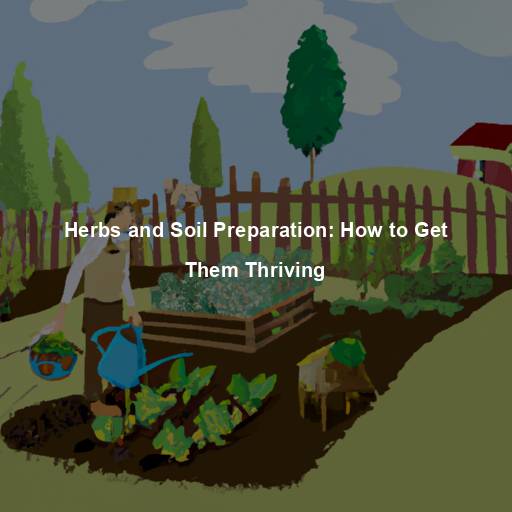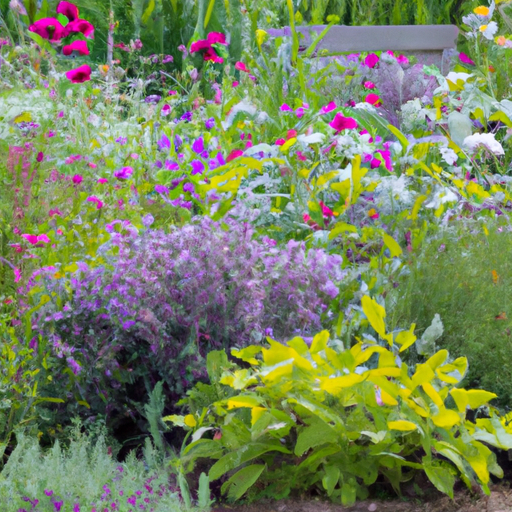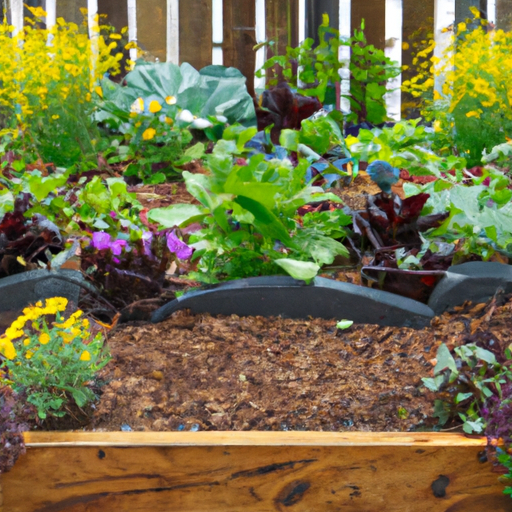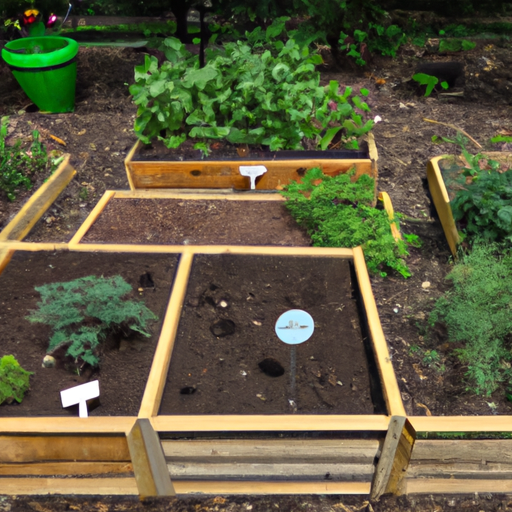Hey there, fellow gardeners! If you’re a fan of using herbs in your cooking or for medicinal purposes, then you know how important it is to have healthy and thriving plants. The key to achieving this lies in not only choosing the right herbs for your soil type and climate but also ensuring that your soil is properly prepared to support their growth.
When it comes to selecting herbs for your garden, it’s essential to take into account factors such as sunlight exposure, moisture levels, and pH balance. Additionally, different types of herbs require specific growing conditions which need to be adequately addressed if you want them to thrive.
But even if you’ve got all these things sorted out, without proper soil preparation, your efforts may fall short. That’s why today we’ll be discussing how you can get your herb garden flourishing by focusing on the importance of soil preparation.
So let’s dig in (pun intended) and learn some tips and tricks on how we can create an optimal environment for our beloved herbs!
Understanding Your Soil Type
Understanding your soil type is crucial in creating a thriving herb garden. Soil composition and nutrients play a vital role in determining the health of your plants.
Before planting, it’s essential to test your soil for its pH level, texture, and nutrient content. This will help you determine what kind of amendments or fertilizers you need to add to improve the quality of your soil.
Sandy soils drain quickly but lack nutrients while clay soils retain moisture but can become compacted and limit root growth. Loamy soils are ideal as they have a balanced mix of sand, silt, and clay that allows for good drainage and water retention while also containing enough nutrients for healthy plant growth.
By understanding your soil type, you’ll be able to give your herbs the best possible start in life.
Testing Soil Ph Levels
Now that we understand our soil type, it’s time to test its pH levels. As seasoned gardeners know, the health of your plants depends largely on the pH level of the soil they grow in. If your soil is too acidic or alkaline, you’ll need to adjust it to ensure optimal growth and nutrient absorption.
Here are four essential techniques for testing and adjusting your soil’s pH:
1. Soil Testing Techniques: To determine your soil’s pH level, you can purchase a simple at-home test kit from any gardening store or online retailer. These kits typically involve adding water to a small sample of soil and analyzing the resulting color change with a chart provided by the kit.
2. Lime Treatment: If your soil is too acidic (pH below 6), you can add lime to raise the pH level. The amount of lime needed will depend on how far below 6 your current pH reading is – refer to package instructions or consult with a local gardening expert for guidance.
3. Sulfur Treatment: On the other hand, if your soil is too alkaline (pH above 7), you’ll want to lower the pH level with sulfur treatment instead. Again, dosage will vary based on how high above 7 your readings are; take care not to overdo it as excess sulfur can harm plant roots.
4. Compost Addition: Whether your soils’ pH level falls within an ideal range or requires adjustment, incorporating compost into your planting beds can help maintain healthy levels over time while also providing valuable nutrients for plant growth.
Remember that each plant species has different preferences when it comes to pH levels – some thrive in highly acidic conditions while others prefer more alkaline soils. Be sure to research optimum ranges for any plants you plan on growing before making adjustments!
Adding Organic Matter To Your Soil
As a Master Gardener, I highly recommend adding organic matter to your soil in order to promote healthy herb growth.
One effective method is using compost tea, which provides a concentrated source of nutrients and beneficial microorganisms. Simply mix the compost with water and let it steep for several days before applying to your herbs.
Another option is planting cover crops such as clover or vetch, which help improve soil structure and provide nitrogen fixation.
These methods will not only enhance the health of your herbs but also benefit the overall productivity of your garden.
So be sure to incorporate them into your soil preparation routine for thriving results!
Choosing The Right Fertilizers
Oh, choosing the right fertilizers. This is where you separate the wheat from the chaff, my dear gardening enthusiasts!
Let me tell you, there are so many options out there that it can make your head spin faster than a rototiller on steroids. But fear not, for I am here to guide you through this maze of nutrients and chemicals.
First off, let’s talk about organic options. These may take longer to break down and release their goodness into the soil but they’re worth it in terms of sustainability and environmental impact.
On the other hand, synthetic options tend to provide more immediate results but at what cost? Chemicals leaching into our groundwater or polluting nearby ecosystems isn’t exactly an ideal scenario either.
So what do we choose then? My advice: strike a balance between the two by using organic fertilizers as much as possible while supplementing with synthetic ones when needed. It’s all about finding that sweet spot between efficacy and responsibility towards Mother Nature.
Happy gardening!
Providing Adequate Drainage
To ensure that your herbs thrive, it’s crucial to provide adequate drainage. Poorly drained soil can lead to root rot and other issues that can harm the plants.
Here are some tips for improving the drainage in your herb garden:
– Use raised beds: Raised bed solutions can improve drainage by allowing excess water to drain away from the roots of your herbs.
– Add organic matter: Organic matter such as compost or leaf mold can help improve soil structure and increase its ability to drain well.
– Mulching techniques: Applying mulch around your herbs can help prevent water from pooling on top of the soil and encourage better absorption into the ground.
– Avoid compacted soil: Compacted soil prevents proper air circulation and water movement through the soil, leading to poor drainage.
By implementing these strategies, you’ll be able to create an environment where your herbs will flourish. Remember, good drainage is essential for healthy plant growth!
Frequently Asked Questions
How Often Should Herbs Be Watered?
When it comes to watering herbs, frequency is key.
Overwatering can lead to root rot and other issues that can damage the health of your plants.
However, underwatering can also be detrimental, causing stunted growth and withered leaves.
So how often should you water?
The answer depends on a variety of factors including weather conditions, soil type, and plant species.
As a Master Gardener, I recommend checking the moisture levels in the soil before watering and adjusting based on the needs of your individual herbs.
Remember to consider both the current weather patterns and any previous rainfall when determining watering frequency.
With proper attention and care, your herbs will thrive and enhance both your cooking and gardening experiences.
What Are Some Common Pests That Can Damage Herb Plants And How Can They Be Prevented?
As any Master Gardener knows, pests can wreak havoc on herb plants. From aphids to spider mites, these tiny invaders can quickly infest and destroy your precious herbs.
But fear not! Companion planting is a natural pest control method that involves pairing certain plants together to deter pests. For instance, planting marigolds alongside your herbs can repel nematodes and other harmful insects.
Additionally, using organic solutions like neem oil or insecticidal soap can also help keep pests at bay without harming the environment or your herbs.
With a little know-how and some proactive measures, you can protect your herbal bounty from pesky intruders and enjoy thriving plants all season long.
Can Herbs Be Grown Indoors And If So, What Special Considerations Should Be Taken?
If you’re thinking about growing herbs indoors, there are a few things to consider.
First and foremost is lighting. Herbs need plenty of light in order to thrive, so be sure your indoor space gets enough natural sunlight or invest in some high-quality grow lights.
Additionally, container size is important to keep in mind – while many herbs can do well in smaller pots, others may require larger containers to accommodate their root systems.
With the right care and attention paid to these factors, you’ll be able to enjoy fresh herbs all year round!
How Do Different Herbs Differ In Their Soil And Nutrient Needs?
Different herbs have varying soil and nutrient requirements that need to be considered when growing them.
Container gardening is a great option for those who want to grow herbs indoors or in small spaces, as it allows for more control over the type of soil used.
Hydroponic herbs are another alternative that can provide optimal nutrition without the use of soil.
It’s important to research each herb individually to ensure you’re providing the appropriate nutrients and pH levels for their specific needs.
For example, basil prefers well-draining soil with a neutral pH level, while rosemary thrives in slightly alkaline soil with good drainage.
By understanding these differences and tailoring your approach accordingly, you can successfully grow a variety of healthy herbs at home.
What Are Some Common Mistakes To Avoid When Growing Herbs In Soil?
When growing herbs in soil, it’s important to avoid common mistakes that can hinder their growth.
One mistake is not properly preparing the soil by incorporating composting tips such as adding organic matter and avoiding chemical fertilizers.
Another factor to consider is the pH level of the soil, which should be between 6-7 for most herbs. Testing the soil regularly can help ensure proper pH levels.
As a Master Gardener, I recommend also considering factors like sunlight and water needs when growing herbs in soil.
By avoiding these mistakes and providing optimal conditions, your herb garden will thrive!
Conclusion
As a Master Gardener, I have seen first-hand the benefits of growing herbs in soil. However, it takes more than just planting and watering to get them thriving. Knowing how often to water your herbs is crucial for their growth and survival.
Overwatering can lead to root rot while underwatering can cause dehydration. Furthermore, pests like aphids and spider mites are notorious for damaging herb plants. Preventative measures such as using organic pesticides or introducing beneficial insects like ladybugs can help keep these pesky bugs at bay.
If you’re considering growing herbs indoors, be sure to provide ample light and proper drainage for optimal growth. Different herbs also have varying soil and nutrient needs, so it’s important to do your research before planting them together. For instance, basil prefers well-draining soil with plenty of nitrogen while thyme thrives in sandy soils with less moisture retention.
Lastly, avoid common mistakes such as overcrowding plants or not providing enough space for roots to grow. In conclusion, by following these tips on soil preparation and herb care, you’ll soon be enjoying a bountiful harvest of fresh herbs right from your own garden!
As the famous poet Robert Frost once said: ‘The best things in life are nearest: Breath in your nostrils, light in your eyes…and flowers at your feet.’ So go ahead and take that first step towards cultivating a healthy herb garden – trust me, your taste buds will thank you!






